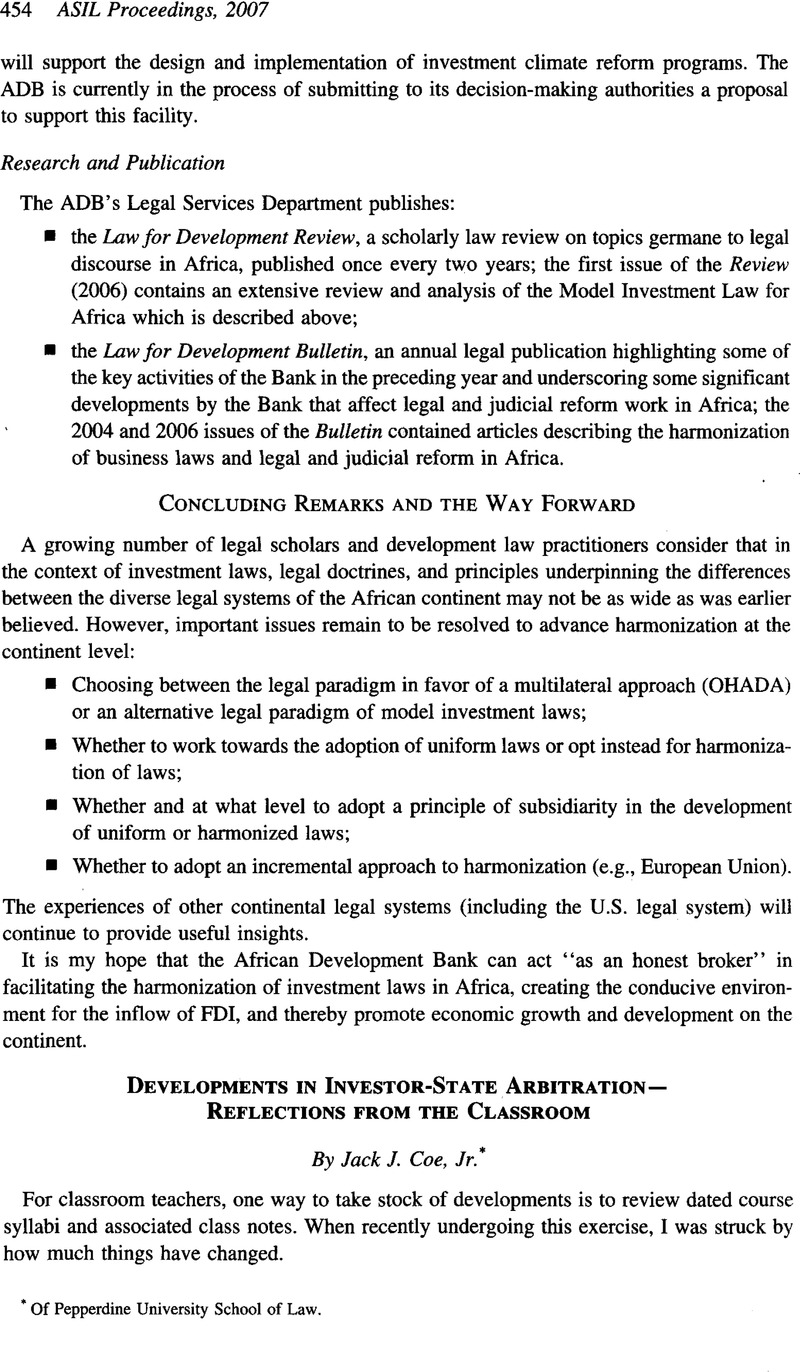No CrossRef data available.
Article contents
Developments in Investor-State Arbitration—Reflections from the Classroom
Published online by Cambridge University Press: 28 February 2017
Abstract

- Type
- Investment Law, Dispute Resolution, and the Development Promise: Back to the Future
- Information
- Copyright
- Copyright © American Society of International Law 2007
References
1 See Shihata, Ibrahim, Towards Greater Depolitization of Investment Disputes: The Roles of ICSID and MIGA, 1 ICSID Rev. 1, 11 (1986)CrossRefGoogle Scholar (few states have insisted upon exhaustion when ratifying the ICSID Convention).
2 See Coe., Jack J. C. Jr., Taking Stock of NAFTA Chapter II in its Tenth Year: An Interim Sketch of Selected Themes, Issues, and Methods, 36 Vand. J. Transnat’l Law 1381 (2003)Google Scholar.
3 See generally Muchlinski, Peter, The Rise and Fall of the Multilateral Agreement on Investment: Where Now?, 34 Int’L Law. 1033 (2000)Google Scholar.
4 See generally Caron, David, Reputation and Reality in the ICSID Annulment Process: Understanding the Distinction Between Annulment and Appeal, 7 ICSID Rev. 21 (1992)CrossRefGoogle Scholar.
5 See, e.g., 1994 ICSID Annual Report 6-7 (1994) (listing five active cases).
6 See List of ICSID Concluded Cases, available at <http://www.worldbank.org/ICSID/cases/cases.htm>.
7 Careful observers might well have anticipated that NAFTA Chapter Eleven would afford new opportunities under the Additional Facility. As is the case today, of the three NAFTA states, only the United States had ratified the ICSID Convention. Accordingly, in the event a NAFTA investment gave rise to a claim, standard ICSID Convention arbitration would not be available; the case could, however, be brought under the Additional Facility if the claimant were a U.S. investor or the United States were the respondent.
8 See UNCTAD, Bilateral Investment Treaties 1995-2006: Trends in Investment Rulemaking 1 (2007).
9 NAFTA is a cardinal example.
10 See UNCTAD, Recent Developments in International Investment Agreements, Aug. 30, 2005 (Research Note).
11 See id. at 11.
12 See id. at 13-14.
13 See List of cases, supra note 6.
14 See id.
15 See Recent Developments, supra note 10 at 14 (56 known non-ICSID cases including 39 under the UNCITRAL Rules).
16 Id.
17 Id.
18 See Muchlinski, supra note 3.
19 See id. at 73-75.
20 See id. at 31-33; Coe. supra note 2, at 1427-30.
21 See Fortier, L. Yves & Drymer, Stephen L, Indirect Expropriation in the Law of International Investment: I Know it When I See It, or Caveat Investor, 19 ICSI Rev. 293 (2004)CrossRefGoogle Scholar.
22 See Bjorklund, Andrea, Emergency Exceptions to International Obligations in the Realm of Foreign Investment: The State of Necessity and Force Majeure as Circumstances Precluding Wrongfulness, in Handbook of International Investment Law (Muchlinski, Peter & Ortino, Federico eds., 2007)Google Scholar.
23 Maffezini v. Spain, ICSID Case No. ARB/97/7.
24 See generally Freyer, Dana & Herlihy, David, Most Favored Nation Treatment and Dispute Settlement in Investment Arbitration: Just How Favored is Most Favored? 20 ICSID Rev. 58 (2005)CrossRefGoogle Scholar.
25 See Legum, Barton, The Introduction of an Appellate Mechanism: The U.S. Trade Act of 2002, in Annulment of ICSID Awards 289 (Banifatemi, Yas & Gaillard, Emmanuel eds., 2004)Google Scholar; Coe, supra note 2, at 1451-53.
26 See Eugene Staley, War and the Private Investor Ch. 19, App. B (1935).
27 See Holtzmann, Howard M. Drafting the Rules of the Tribunal, in The Iran-United States Claims Tribunal 75, 83-84 (Caron, David & Crook, John eds., 2000)Google Scholar; Coe, Jack J. Jr.., Transparency in the Resolution of Investor-State Disputes-Adoption, Adaptation and NAFTA Leadership, 54 U. Kan. L. Rev. 1339, 1355-59 (2006)Google Scholar. See Legum, supra note 25.
29 See Emmanuel Gaillard, A Black Year at ICSID, N.Y. L. J., Mar. 1, 2007 (discussing Mitchell v. Congo).
30 See U.S. Model Bit Concerning the Encouragement and Reciprocal Protection of Investment (2004), available at <http://www.NAFTAclaims.com>
31 See Legurn, Barton, Learned from the NAFTA: The New Generation of U.S. Investment Treaty Arbitration Provisions, 19 ICSID Rev. 344 (2004)Google Scholar; Coe, Jack J. Jr.,, The State of Investor-State Arbitration—Some Reflections on Professor Brower’s Plea for Sensible Principles, 20 Am. U. Int’l L. Rev. 942-45 (2005)Google Scholar.
32 The 2004 U.S. Model, Art. 4, explicitly refers to fair and equitable treatment as being included in customary international law, thus discouraging arguments not predicated on custom.
33 See Coe, supra note 31, at 943-44 (2005).
34 See Legum, supra note 31, at 352-53.
35 See generally Stephen M. Schwebel, The United States 2004 Model Bilateral Investment Treaty: An Exercise in the Regressive Development of International Law, paper presented as part of ABA (SILP) Audio Conference Series (2006).
36 The 2004 U.S. Model, supra note 32, provides in Article 29(2) that the tribunal “shall conduct hearings open to the public . . .”.
37 See id., Art. 28(3) (confirming the tribunal’s authority to accept amicus submissions).
38 See Coe, supra note 27 at 1348-52.
39 See The Future of Interstate Arbitration, 4th Annual ITA-ASIL Conference (Mar. 28, 2007).
40 See, e.g., UNCITRAL Arbitration Rules, Art. 25(4) (hearing to be held in camera subject to the parties’ agreement to the contrary).
41 See Antonio Parra, The Development of the Regulations and Rules of the International Centre for Settlement of Investment Disputes 47 (2007).
42 Annex B of the U.S. Model confirms the parties’ understanding that the required case-by-case, factual inquiry is to consider, inter alia, “the economic impact of the government act. . . , the extent to which the government action interferes with distinct, reasonable investment backed expectations, and the character of the government action.”
43 Penn Central Transp. Co. v. New York City 438 U.S. 104, 124 (1978).


